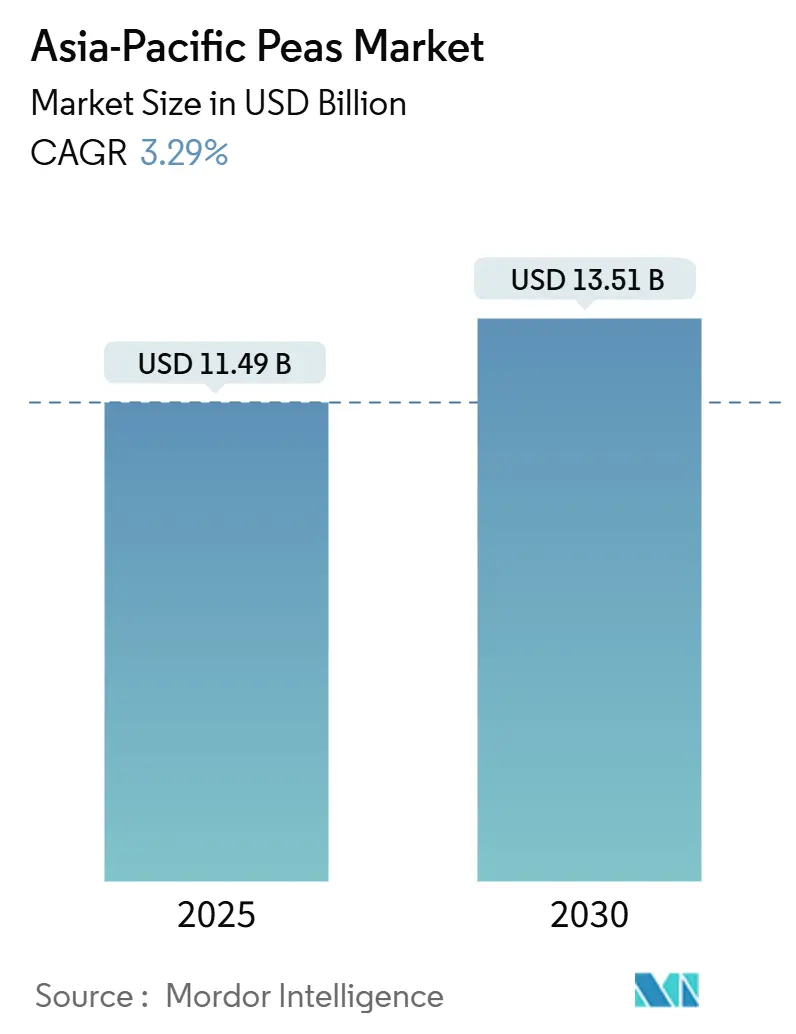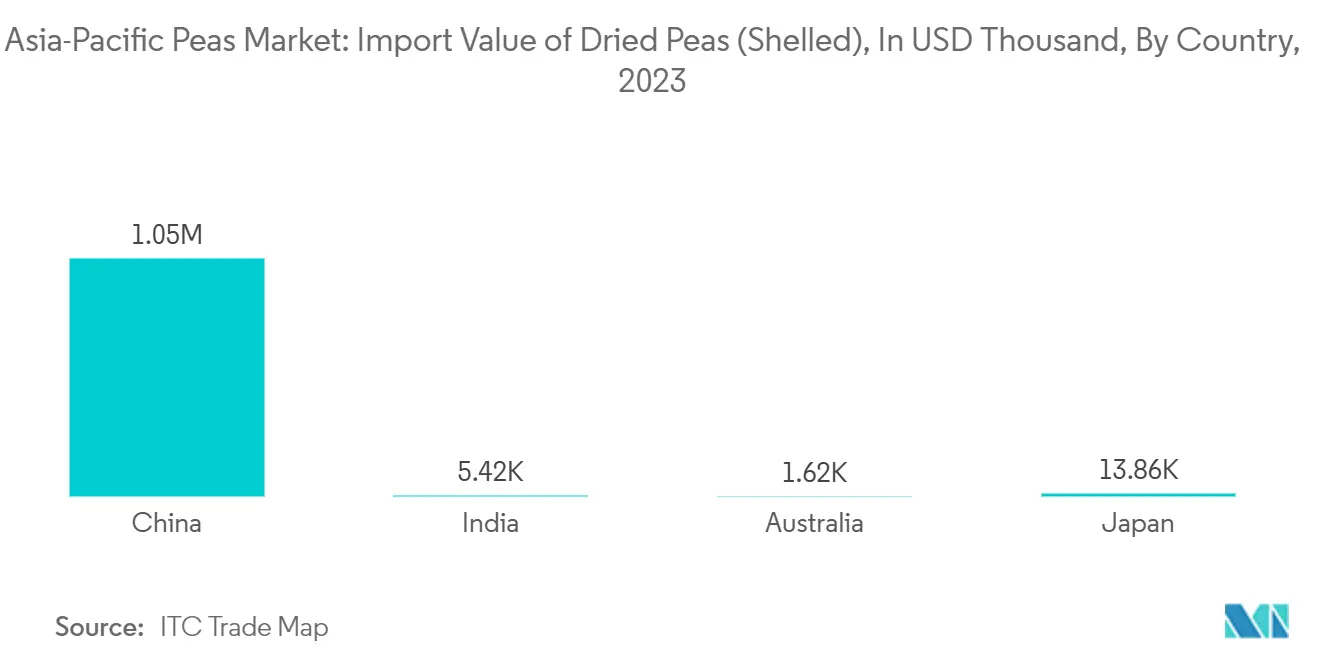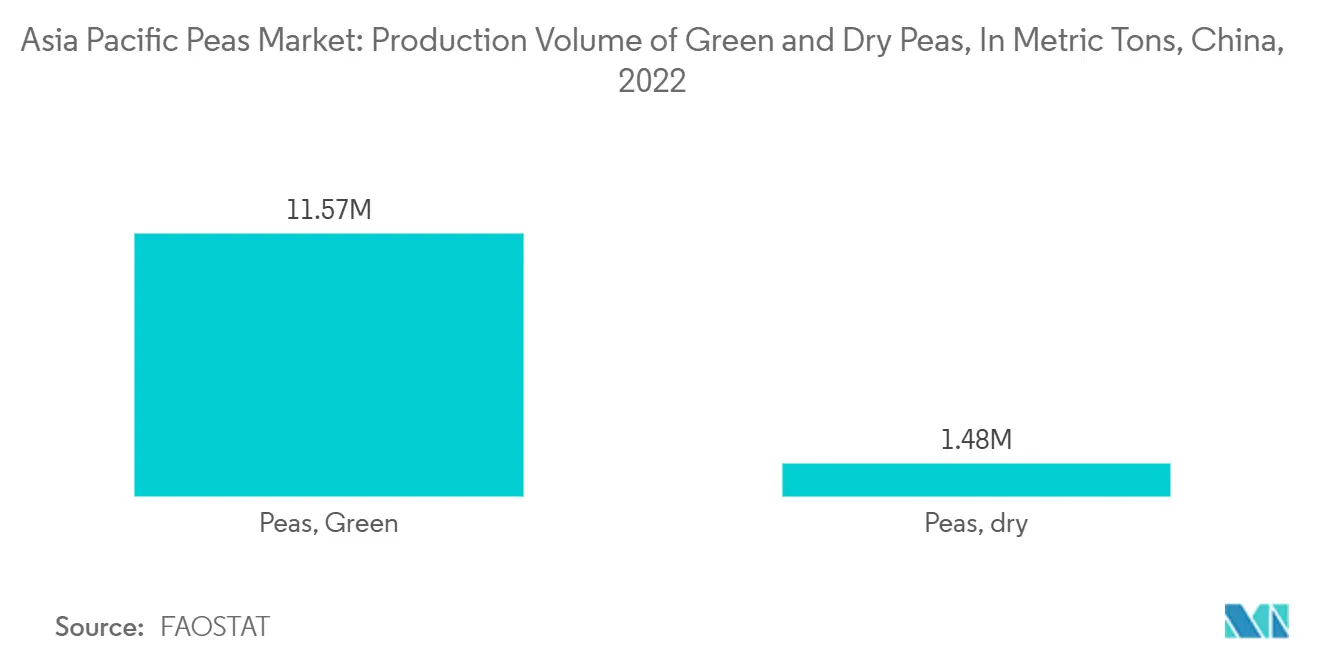
Asia-Pacific Peas Market Analysis by Mordor Intelligence
The Asia-Pacific Peas Market size is estimated at USD 11.49 billion in 2025, and is expected to reach USD 13.51 billion by 2030, at a CAGR of 3.29% during the forecast period (2025-2030).
- Peas are the fourth-most important legume crop in Asia-Pacific, after soybeans, groundnuts, and beans. They serve as both food and animal feed. The region cultivates various pea types, including garden peas (fresh and green varieties) and dried peas. Feed manufacturers are incorporating pea protein into animal feed to improve its functionality. This diversification of pea applications beyond food consumption is anticipated to drive market growth in the coming years.
- China, India, and Australia are major pea producers in the region, benefiting from suitable climatic conditions and established agricultural practices. China is a leading producer, utilizing its extensive agricultural resources, while India focuses on dry peas, supported by high domestic consumption. Green peas are the predominant variety produced in most countries in the region. According to the Food and Agriculture Organization (FAO), India produced 6.2 million metric tons of green peas in 2022, while dry peas accounted for 1.0 million metric tons in the same year.
- The United States is implementing the Gus Schumacher Nutrition Incentive Program (GusNIP), administered by the USDA's National Institute of Food and Agriculture (NIFA). GusNIP is designed to increase the purchase of fruits and vegetables by providing incentives at the point of sale for eligible consumers participating in the USDA Supplemental Nutrition Assistance Program (SNAP) across all 50 states. Factors such as expanding cultivation areas, increasing production, growing health awareness, urbanization, and the rising popularity of plant-based diets are projected to drive the peas market across the region during the forecast period.
Asia-Pacific Peas Market Trends and Insights
Consumption Demand for Plant-Based Protein (Peas) Ingredients
Consumer demand for plant protein ingredients, including pea protein, is increasing in the Asia-Pacific region due to the growing preference for healthy meat alternatives. In India, where a significant portion of the population is vegetarian, the consumption of vegetarian and vegan products is notably high. China is experiencing a trend in plant protein demand, primarily attributed to rising incomes. The growing fitness-conscious population and a gradual shift from meat products to vegan protein diets are key factors driving the demand for peas in the market. Pea proteins have gained popularity in China due to their high nutritional qualities and increased Western influence.
The increasing demand for peas in Asia-Pacific countries, particularly India and China, has corresponded with high production levels in 2023. According to the ITC Trade Map, China's import volume of dried peas increased by 64.2%, from 1.62 million metric tons in 2022 to 2.66 million metric tons in 2023. Similarly, India's import volume of dried and shelled peas rose significantly from 1.63 thousand metric tons in 2022 to 10.98 thousand metric tons in 2023. The growing demand for pea protein ingredients presents numerous opportunities for producers. The emergence of pea protein as a value-added product in a traditionally direct-consumption market is projected to enhance growth prospects for pea processors and food manufacturers. This trend is anticipated to drive market growth for peas during the forecast period.

China Dominates the Market
China is the major peas-producing as well as consuming country in the Asia Pacific region. China produces both fresh and dry peas. The production of peas is mainly carried out in the Ningxia, Gansu, Yunnan, and Qinghai provinces of China. Most of the locally produced dried peas are consumed near their production area. Due to the increasing demand for dried peas from the food processing sector and the animal feed sector in China, production has increased over the past two years. For instance, according to the Food and Agriculture Organization (FAO), in the year 2020, the production volume was observed at 1,442.9 thousand metric tons which increased to 1,496.5 thousand metric tons in the year 2022.
Also, due to the large land availability, the production of fresh peas is significant in the country which accounted for 11.57 million metric tons which was high among all the other Asia Pacific countries. Thus, the increasing demand for both dry peas as well as fresh peas is going to drive the Asia-Pacific peas market during the forecast period.

Recent Industry Developments
- November 2024: China has approved the import of peas from Ukraine by accepting their phytosanitary protocol. Subsequently, Ukraine's domestic approval process for the phytosanitary measures has reached its final stages. Once China grants final approval, the import of Ukrainian peas to China is anticipated to commence.
- January 2023: Roquette company invested in DAIZ Inc., a Japanese food tech startup. This partnership allowed Roquette and DAIZ to continue realizing their strong growth ambitions and meet rising global demand for innovative and sustainable plant-based ingredients including pea protein.
- April 2022: Cargill Inc. expanded the availability of RadiPure pea protein in India. This expansion of product availability helped to enhance the consumption of peas as a raw material in the Asia-Pacific region.
Asia-Pacific Peas Market Report Scope
Pea crop is a grain legume that produces high protein feed for animals, as well as human nutrition. Peas are a rich source of proteins, amino acids, and sugars. Also, they are fairly low in calories and contain several vitamins, minerals, and antioxidants. The Asia Pacific peas market is segmented by production (volume), consumption (value and volume), import (volume and value), export (volume and value), and price trend analysis covering major countries such as China, India, Japan, and Australia. The report offers market size and forecasts in terms of value (USD) and Volume (metric tons) for all the above-mentioned segments.
| Asia-Pacific | China | Production Analysis |
| Consumption Analysis and Market Value | ||
| Import Market Analysis (Volume and Value) | ||
| Export Market Analysis (Volume and Value) | ||
| Price Trend Analysis | ||
| Australia | Production Analysis | |
| Consumption Analysis and Market Value | ||
| Import Market Analysis (Volume and Value) | ||
| Export Market Analysis (Volume and Value) | ||
| Price Trend Analysis | ||
| India | Production Analysis | |
| Consumption Analysis and Market Value | ||
| Import Market Analysis (Volume and Value) | ||
| Export Market Analysis (Volume and Value) | ||
| Price Trend Analysis | ||
| Japan | Production Analysis | |
| Consumption Analysis and Market Value | ||
| Import Market Analysis (Volume and Value) | ||
| Export Market Analysis (Volume and Value) | ||
| Price Trend Analysis | ||
| Geography | Asia-Pacific | China | Production Analysis |
| Consumption Analysis and Market Value | |||
| Import Market Analysis (Volume and Value) | |||
| Export Market Analysis (Volume and Value) | |||
| Price Trend Analysis | |||
| Australia | Production Analysis | ||
| Consumption Analysis and Market Value | |||
| Import Market Analysis (Volume and Value) | |||
| Export Market Analysis (Volume and Value) | |||
| Price Trend Analysis | |||
| India | Production Analysis | ||
| Consumption Analysis and Market Value | |||
| Import Market Analysis (Volume and Value) | |||
| Export Market Analysis (Volume and Value) | |||
| Price Trend Analysis | |||
| Japan | Production Analysis | ||
| Consumption Analysis and Market Value | |||
| Import Market Analysis (Volume and Value) | |||
| Export Market Analysis (Volume and Value) | |||
| Price Trend Analysis | |||
Key Questions Answered in the Report
How big is the Asia-Pacific Peas Market?
The Asia-Pacific Peas Market size is expected to reach USD 11.49 billion in 2025 and grow at a CAGR of 3.29% to reach USD 13.51 billion by 2030.
What is the current Asia-Pacific Peas Market size?
In 2025, the Asia-Pacific Peas Market size is expected to reach USD 11.49 billion.
What years does this Asia-Pacific Peas Market cover, and what was the market size in 2024?
In 2024, the Asia-Pacific Peas Market size was estimated at USD 11.11 billion. The report covers the Asia-Pacific Peas Market historical market size for years: 2019, 2020, 2021, 2022, 2023 and 2024. The report also forecasts the Asia-Pacific Peas Market size for years: 2025, 2026, 2027, 2028, 2029 and 2030.
Page last updated on:
Asia-Pacific Peas Market Report
Statistics for the 2025 Asia-Pacific Peas market share, size and revenue growth rate, created by Mordor Intelligence™ Industry Reports. Asia-Pacific Peas analysis includes a market forecast outlook for 2025 to 2030 and historical overview. Get a sample of this industry analysis as a free report PDF download.


